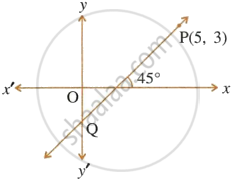Advertisements
Advertisements
प्रश्न
Show that the points P(a, b + c), Q(b, c + a) and R(c, a + b) are collinear.
उत्तर
Let ∴ P(a, b + c) = (x1, y1)
∴ Q(b, c + a) = (x2, y2)
∴ R(c, a + b) = (x3, y3)
The points P, Q, R will be collinear if slope of PQ and QR is the same.
Slope of PQ = `(y_2 - y_1)/(x_2 - x_1)`
= `(c + a - (b + c))/(b - a)`
=`(c + a - b - c)/(b - a)`
= `(a - b)/(b - a)`
= `(- (b - a))/(b - a)`
= –1
Slope of QR = `(y_3 - y_2)/(x_3 - x_2)`
= `((a + b) - (c + a))/(c - a)`
= `(a + b - c - a)/(c - b)`
= `(b - c)/(c - b)`
= `(- (c - b))/(c - b)`
= –1
Hence, the points P, Q, and R are collinear.
APPEARS IN
संबंधित प्रश्न
Find the slope of the line parallel to AB if : A = (−2, 4) and B = (0, 6)
The points (−3, 2), (2, −1) and (a, 4) are collinear. Find a.
Find the value(s) of k so that PQ will be parallel to RS. Given : P(5, −1), Q(6, 11), R(6, −4k) and S(7, k2)
The line through P(5, 3) intersects y-axis at Q.
- Write the slope of the line.
- Write the equation of the line.
- Find the co-ordinates of Q.

Find the slope of a line parallel to the given line 5x + 2y = 11
Verify whether the following points are collinear or not:
A(1, –3), B(2, –5), C(–4, 7).
Find the slope of the line passing through the points M(4,0) and N(-2,-3).
The line through A (- 2, 3) and B (4, b) is perpendicular to the line 2a – 4y = 5. Find the value of b.
Prove that A(4, 3), B(6, 4), C(5, 6) and D(3, 5) are the angular points of a square.
The vertices of a triangle are A(10, 4), B(- 4, 9) and C(- 2, -1). Find the
